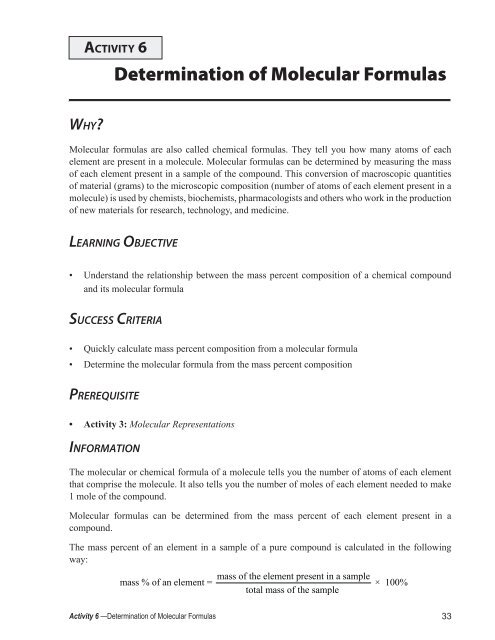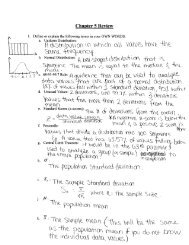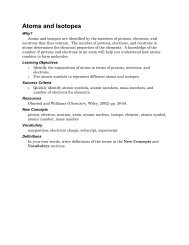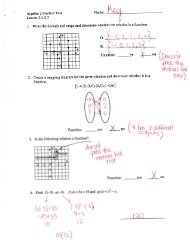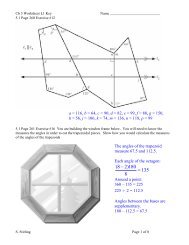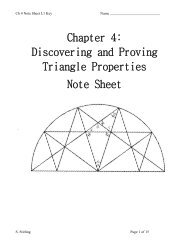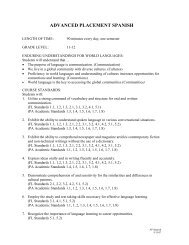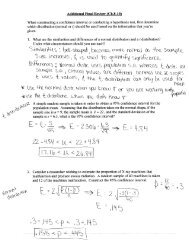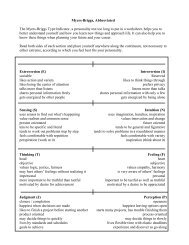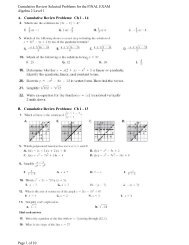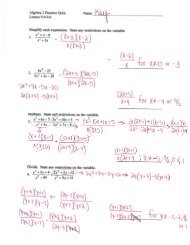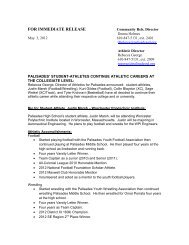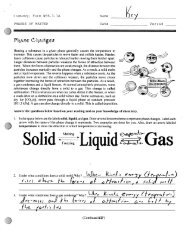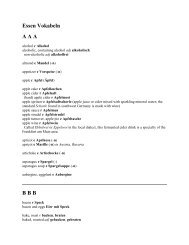Determination of Molecular Formulas
Determination of Molecular Formulas
Determination of Molecular Formulas
Create successful ePaper yourself
Turn your PDF publications into a flip-book with our unique Google optimized e-Paper software.
Activity 6<br />
<strong>Determination</strong> <strong>of</strong> <strong>Molecular</strong> <strong>Formulas</strong><br />
Why?<br />
<strong>Molecular</strong> formulas are also called chemical formulas. They tell you how many atoms <strong>of</strong> each<br />
element are present in a molecule. <strong>Molecular</strong> formulas can be determined by measuring the mass<br />
<strong>of</strong> each element present in a sample <strong>of</strong> the compound. This conversion <strong>of</strong> macroscopic quantities<br />
<strong>of</strong> material (grams) to the microscopic composition (number <strong>of</strong> atoms <strong>of</strong> each element present in a<br />
molecule) is used by chemists, biochemists, pharmacologists and others who work in the production<br />
<strong>of</strong> new materials for research, technology, and medicine.<br />
Learning Objective<br />
• Understand the relationship between the mass percent composition <strong>of</strong> a chemical compound<br />
and its molecular formula<br />
Success Criteria<br />
• Quickly calculate mass percent composition from a molecular formula<br />
• Determine the molecular formula from the mass percent composition<br />
Prerequisite<br />
• Activity 3: <strong>Molecular</strong> Representations<br />
Information<br />
The molecular or chemical formula <strong>of</strong> a molecule tells you the number <strong>of</strong> atoms <strong>of</strong> each element<br />
that comprise the molecule. It also tells you the number <strong>of</strong> moles <strong>of</strong> each element needed to make<br />
1 mole <strong>of</strong> the compound.<br />
<strong>Molecular</strong> formulas can be determined from the mass percent <strong>of</strong> each element present in a<br />
compound.<br />
The mass percent <strong>of</strong> an element in a sample <strong>of</strong> a pure compound is calculated in the following<br />
way:<br />
mass <strong>of</strong> the element present in a sample<br />
mass % <strong>of</strong> an element = × 100%<br />
total mass <strong>of</strong> the sample<br />
Activity 6 —<strong>Determination</strong> <strong>of</strong> <strong>Molecular</strong> <strong>Formulas</strong> 33
The mass % <strong>of</strong> an element in a compound can also be calculated if the molecular formula is known.<br />
This calculation is done in the following way.<br />
x 100%<br />
mass % <strong>of</strong> an element =<br />
mass <strong>of</strong> the element in one mole <strong>of</strong> the compound<br />
molar mass <strong>of</strong> the compound<br />
× 100%<br />
For example, to calculate the percent C in propene, C 3 H 6 : the mass <strong>of</strong> carbon in 1 mol propene<br />
is 3 × 12.01 g/mol = 36.03 g/m. The molar mass <strong>of</strong> propene is 42.08 g/mol, so dividing 36.03 by<br />
42.12 and multiplying by 100% produces 85.62%.<br />
Model 1: What Do these Different Compounds Have in<br />
Common?<br />
Table 6.1<br />
Name<br />
Line Structure<br />
<strong>Molecular</strong><br />
Formula<br />
Mass % Composition<br />
C<br />
H<br />
ethene<br />
propene C 3 H 6 85.64 14.38<br />
1-butene<br />
2-butene<br />
1-pentene<br />
2-pentene<br />
Task<br />
Complete Table 6.1 for Model 1 by filling in the molecular formula and the mass percent composition<br />
information.<br />
34<br />
Foundations <strong>of</strong> Chemistry
Key Questions<br />
1. What are common features <strong>of</strong> the six compounds in Model 1 that you can identify from<br />
Table 6.1?<br />
2. Is it possible to determine the molecular formula <strong>of</strong> a compound from the mass percent<br />
composition? Explain why or why not.<br />
3. How are the molecular formulas <strong>of</strong> the six compounds in Model 1 similar, and how are they<br />
different?<br />
Information<br />
An empirical formula for a compound contains integer subscripts that provide the ratio <strong>of</strong> elements<br />
in the compound by using the smallest whole numbers. The molecular formula is some multiple <strong>of</strong><br />
the empirical formula. Additional information, for example the molar mass, is needed to determine<br />
the molecular formula from the empirical formula.<br />
Key Questions<br />
4. What is the empirical formula for the compounds in Model 1?<br />
Model 2: Chemical Analysis <strong>of</strong> Acetic Acid<br />
Acetic acid is the active ingredient in vinegar. A chemical analysis <strong>of</strong> 157.5 g <strong>of</strong> acetic acid provided<br />
the following information:<br />
Table 6.2<br />
Element Mass <strong>of</strong> Element (g) Moles <strong>of</strong> Element<br />
Whole Number<br />
Ratio<br />
carbon 63.00 5.246 5.246/5.246 = 1<br />
oxygen 83.93 5.246 5.246/5.246 = 1<br />
hydrogen 10.57 10.486 10.486/5.246 = 2<br />
moles = mass <strong>of</strong> element / molar mass <strong>of</strong> element<br />
The 1:1:2 ratio in the last column means that the empirical formula is (COH 2 ).<br />
Activity 6 —<strong>Determination</strong> <strong>of</strong> <strong>Molecular</strong> <strong>Formulas</strong> 35
Key Questions<br />
5. How was the number <strong>of</strong> moles <strong>of</strong> each element calculated?<br />
6. How were the ratios <strong>of</strong> the elements in acetic acid determined from the moles <strong>of</strong> each element<br />
present in the sample?<br />
7. How is the empirical formula determined from the ratios <strong>of</strong> the elements present in the<br />
sample?<br />
8. What information does the empirical formula provide?<br />
9. What is the relationship between the ratio <strong>of</strong> moles <strong>of</strong> each element present in the sample, and<br />
the ratio <strong>of</strong> the number <strong>of</strong> atoms <strong>of</strong> each element present in each molecule <strong>of</strong> acetic acid?<br />
10. Why is the atomic mass percent composition <strong>of</strong> an unknown chemical compound an important<br />
quantity to determine in a chemical analysis?<br />
36<br />
Foundations <strong>of</strong> Chemistry
Exercises<br />
1. Sodium carbonate has the molecular formula Na 2 CO 3 . Calculate the molar mass <strong>of</strong> this<br />
compound, the mass percent composition <strong>of</strong> each element in the compound, and the mass <strong>of</strong><br />
each element present in a 73.6 g sample.<br />
Molar mass calculation:<br />
(2 × 22.99) + (12.01) + (3 × 16.00) = 105.99 g/mol<br />
Mass percent calculations:<br />
(2 × 22.99)<br />
105.99<br />
× 100% = 43.38% Na<br />
12.01<br />
100% 11.33% C<br />
105.99 × =<br />
(3 × 16.00)<br />
105.99<br />
× 100% = 45.29% O<br />
Amount in 73.6 g sample: multiply the percent by 73.6 g to get:<br />
31.91 g Na<br />
8.339 g C<br />
33.33 g O<br />
2. A sample <strong>of</strong> sodium bicarbonate (baking soda) was found to consist <strong>of</strong> 9.122 g Na, 0.4000 g<br />
H, 4.766 g C, and 19.04 g O. Calculate the moles <strong>of</strong> each element present, and determine the<br />
empirical formula <strong>of</strong> sodium bicarbonate.<br />
9.122 g Na<br />
22.99 g Na/mol Na =<br />
0.3968 mol Na<br />
0.4000 g H<br />
1.008 g H/mol H =<br />
4.766 g C<br />
12.01 g C/mol C =<br />
19.04 g O<br />
16.00 g O/mol O =<br />
0.3968 mol H<br />
0.3968 mol C<br />
1.19 mol O<br />
Divide all by the smallest:<br />
0.3968 1.19<br />
= 1 and = 3<br />
0.3968 0.3968<br />
So mol ratio is 1:1:1:3, so the empirical formula is NaHCO 3<br />
Activity 6 —<strong>Determination</strong> <strong>of</strong> <strong>Molecular</strong> <strong>Formulas</strong> 37
Problems<br />
1. Show how you can determine the molecular formula for acetic acid, which is found in vinegar,<br />
given the empirical formula CH 2 O and the added information that the molar mass <strong>of</strong> acetic acid<br />
is 60.05 g/mole.<br />
38<br />
Foundations <strong>of</strong> Chemistry
2. One <strong>of</strong> the chlor<strong>of</strong>luorocarbons (a freon), which is used in refrigerator compressors and<br />
contributes to destruction <strong>of</strong> ozone in the upper atmosphere, has a molar mass <strong>of</strong> 132.9 g/mole<br />
and a percent composition <strong>of</strong> 53.34% Cl, 28.59% F, and 18.07% C. Hint: Whenever the data<br />
give the percent <strong>of</strong> the elements present rather than the mass, you can assume any sample size<br />
and calculate the mass. Why is it particularly convenient to assume the data came from a 100 g<br />
sample?<br />
a) How many grams <strong>of</strong> chlorine are there in a 100 g sample <strong>of</strong> the freon?<br />
b) How many moles <strong>of</strong> chlorine are there in a 100 g sample <strong>of</strong> the freon?<br />
53.34 g<br />
35.45 g /mol<br />
=<br />
1.50 moles chlorine<br />
c) What is the ratio <strong>of</strong> the moles <strong>of</strong> chlorine to the moles <strong>of</strong> carbon in this freon?<br />
moles <strong>of</strong> C<br />
18.07 g<br />
= =<br />
12.01 g/mol<br />
1.5 mol carbon<br />
so 1.5:1.5 = 1:1 ratio <strong>of</strong> chlorine to carbon in this freon.<br />
d) Determine the empirical and molecular formulas <strong>of</strong> this freon.<br />
mol <strong>of</strong> F<br />
28.59 g<br />
= =<br />
19.0 g/mol<br />
1.50 mol F<br />
so CClF is the empirical formula.<br />
the empirical formula molar mass is 66.45 g/mol,<br />
which is half the molar mass <strong>of</strong> the compound,<br />
so Cl 2 F 2 C 2 is the molecular formula.<br />
Activity 6 —<strong>Determination</strong> <strong>of</strong> <strong>Molecular</strong> <strong>Formulas</strong> 39
3. Combustion <strong>of</strong> 10.68 mg <strong>of</strong> a compound containing only C, H, and O produces 16.01 mg CO 2<br />
and 4.37 mg H 2 O. The molar mass <strong>of</strong> the compound is 176.1 g/mol. What is the empirical<br />
formula <strong>of</strong> the compound? What is the molecular formula <strong>of</strong> the compound?<br />
Hints<br />
The empirical formula gives the proportions in terms <strong>of</strong> mole ratios <strong>of</strong> each element present in the<br />
compound. To find the empirical formula, you first need to determine how many moles <strong>of</strong> each<br />
element are present in a sample <strong>of</strong> the compound.<br />
1. You can determine the mass and moles <strong>of</strong> carbon in the compound from the mass <strong>of</strong> carbon<br />
dioxide that was produced in the combustion. Can you explain why the fraction <strong>of</strong> the carbon<br />
dioxide mass that is due to carbon is 12.01/44.01?<br />
12.01 (16.01 mg) = 4.369 mg<br />
44.01<br />
4.369 mg<br />
moles <strong>of</strong> C = = 0.3638 mmol<br />
-1<br />
12.01 g mol<br />
2. You can determine the mass and moles <strong>of</strong> hydrogen in the compound from the mass <strong>of</strong> water that<br />
was produced in the combustion by first determining the fraction <strong>of</strong> the mass <strong>of</strong> water that is due to<br />
hydrogen.<br />
2.016 (4.37 mg) = 0.489 mg<br />
18.016<br />
0.489 mg<br />
moles <strong>of</strong> H = = 0.485 mmol<br />
-1<br />
1.008 g mol<br />
3. You can determine the mass and moles <strong>of</strong> oxygen because the sum <strong>of</strong> O, C, and H masses<br />
must add up to 10.68 mg, which is the mass <strong>of</strong> the sample.<br />
mass <strong>of</strong> oxygen = (10.68 - 4.369 - 0.489) mg = 5.822 mg<br />
moles <strong>of</strong> oxygen<br />
5.822 mg<br />
= = 0.3639 mmol<br />
-1<br />
16.00 g mol<br />
4. From the moles <strong>of</strong> C, H, and O, you can determine the mole ratios, which leads to the empirical<br />
formula.<br />
0.3638 0.485 0.3639<br />
C:H:O = : : = 1.000 : 1.33 : 1.000<br />
0.3638 0.3638 0.3638<br />
5. Given the empirical formula and the molar mass <strong>of</strong> 176.1 g/mol, you can identify the molecular<br />
formula.<br />
40<br />
Foundations <strong>of</strong> Chemistry


